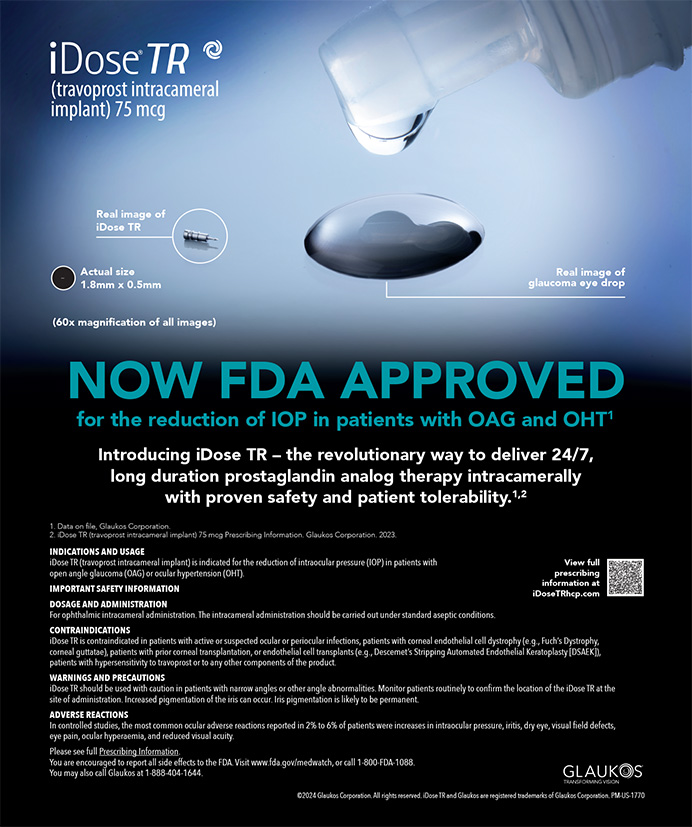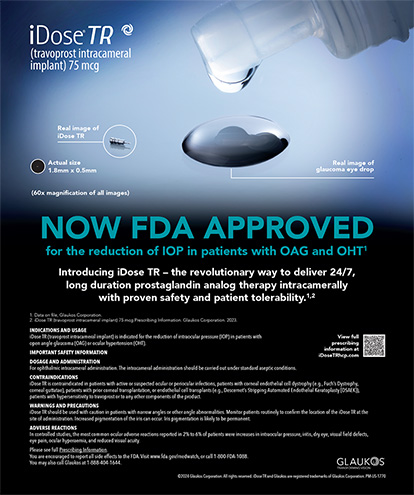Your patient is overweight and reports problems with obstructive sleep apnea (OSA). In the OR, the patient allows you to start the case without incident but, while sedated, begins to have coughing spells, move excessively, etc., threatening the surgical outcome. The anesthesiologist notes that, because of the airway issues, more sedation would be a challenge.
What steps do you take to prevent scenarios such as this one from happening? If those measures prove inadequate, what do you do?
—Topic prepared by Steven Dewey, MD.
LISA BROTHERS ARBISSER, MD
Decide patients' candidacy for topical anesthesia preoperatively. If indirect ophthalmoscopy causes tearing, squeezing, or anxiety, a peribulbar block may be appropriate. Perhaps this situation could have been avoided.
Do not heavily sedate any patient. Sparing patients anxiety and pain without causing unconsciousness— that fine line between comfortable cooperation and sleep—is the goal. I find it particularly hard to gauge dosing in obese patients, so I keep such patients' anesthesia light.
I recommend vocal local. Asking patients to let the surgical team know if they are uncomfortable, assuring them you will respond immediately, and telling them along the way what to expect are the keys to a predictable surgery. Only minute amounts of midazolam (Versed; Roche) and alfentanil hydrochloride (Alfenta; Akorn, Inc.; a short-acting intravenous medication) just before the drape and rarely thereafter are needed.
Patients who are obese and/or have sleep apnea benefit from careful positioning on the table with reverse Trendelenburg, head at or above their heart. I have oxygen blowing under the drape for all of my patients.
My patients are instructed during the prep to let the surgical team know if they feel a cough coming on and to keep their head on the pillow. When predictable or after the first cough on the table, a bolus of intravenous lidocaine eliminates this reflex for about 15 minutes and can be repeated once. I recommend training your scrub technician to immediately put his or her hand on the patient's forehead and to gently press down when he or she coughs. If the eye is filled with an ophthalmic viscosurgical device or if the incision is closed, there is no problem. Do not withdraw instruments during phacoemulsification or I/A. If you stay in place on foot position one or zero to maintain positive pressure, no complication is likely to ensue. It is safe to let the patient clear phlegm. When he or she is done coughing, ask him or her to take one last deep breath to ensure it will not elicit another fit.
Despite precautions, an occasional patient will fall asleep and awaken with movement, jeopardizing the surgical outcome. Verbally rouse patients at intervals when the eye is controlled to avoid sudden waking at awkward moments. In the unpleasant predicament described, it might be necessary to stall with the eye pressurized until the patient became sufficiently alert to understand his or her circumstances. The last resort would be a peribulbar (sub-Tenon) injection for akinesia or to close the eye and induce general anesthesia with intubation.
COLLEEN P. HALFPENNY, MD
As with most things in surgery, the best approach to complications is their prevention. Obese patients with OSA are at increased risk of complications from anesthesia and surgery. Communication and teamwork with your anesthesia team are key. If OSA is recognized, the use of nasal, continuous, positive airway pressure preoperatively and even intraoperatively can make sedation safer. It can be administered through a nasopharyngeal airway, just like oxygen that is routinely given in surgeries. If you are concerned about ocular movement, local anesthesia can augment control without extra sedation. A peribulbar block is preferable to a retrobulbar block for minimizing posterior pressure.
These patients are much more likely to have positive vitreous pressure as well, which increases the chance of capsular rupture upon movement. Proper positioning of the patient in a reverse Trendelenburg position will reduce both central venous pressure and IOP. For an obese patient, the surgeon may have to stand in order to obtain adequate magnification with the microscope. The preoperative administration of intravenous osmotics such as mannitol and acetazolamide (Diamox; Wyeth Pharmaceuticals) will also decrease posterior pressure.
In the setting of a potentially unstable anterior chamber, it is optimal to use bimanual or microcoaxial smallincision phacoemulsification with low-flow parameters and a strongly cohesive viscoelastic. In addition, it is best to use a silicone I/A tip during cortical cleanup.
If all of these measures fail, you might consider conversion to general anesthesia, because a secure airwa is always a safer alternative to deeper sedation without a secure airway in these cases.
ROBERT KAUFER, MD
In this scenario, if the surgery is already underway and I suddenly have to stop, the main thing is to keep the eye closed. Suturing is not always necessary. Usually, elevating the upper part of the patient's body makes him or her more comfortable and allows him or her to breathe more normally. If I could continue after sitting the patient up for a few minutes, I would try to finish as soon as possible. Surgeons must always consider the life of the patient first. If I could not continue, I would have the anesthesiologist intubate the patient and administer general anesthesia in order to finish the surgery.
Having the patient not lie down 100% horizontally is usually enough to prevent this scenario. Sometimes, the surgeon has to operate uncomfortably and may have to bring the pedals closer for easier access. Proper preoperative medication can also be helpful.
Section Editor Alan N. Carlson, MD, is a professor of ophthalmology and chief, corneal and refractive surgery, at Duke Eye Center in Durham, North Carolina.
Section Editor Steven Dewey, MD, is in private practice with Colorado Springs Health Partners in Colorado Springs, Colorado. Dr. Dewey may be reached at (719) 475-7700; sdewey@cshp.net.
Section Editor R. Bruce Wallace III, MD, is the medical director of Wallace Eye Surgery in Alexandria, Louisiana. Dr. Wallace is also a clinical professor of ophthalmology at the Louisiana State University School of Medicine and at the Tulane School of Medicine, both located in New Orleans.
Lisa Brothers Arbisser, MD, is in private practice with Eye Surgeons Assoc. PC, located in the Iowa and Illinois Quad Cities. Dr. Arbisser is also an adjunct associate professor at the John A. Moran Eye Center of the University of Utah in Salt Lake City. She acknowledged no financial interest in the products or companies she mentioned. Dr. Arbisser may be reached at (563) 323-2020; drlisa@arbisser.com.
Colleen P. Halfpenny, MD, is an assistant professor in ophthalmology at Jefferson Medical College in Philadelphia. She acknowledged no financial interest in the product or company she mentioned. Dr. Halfpenny may be reached at (215) 938-7878; halfpenc@gmail.com.
Robert Kaufer, MD, is the medical director of Kaufer Clinica de Ojos in Buenos Aires, Argentina. Dr. Kaufer may be reached at +54 1 1 4733 0560; robert@kaufer.com.


